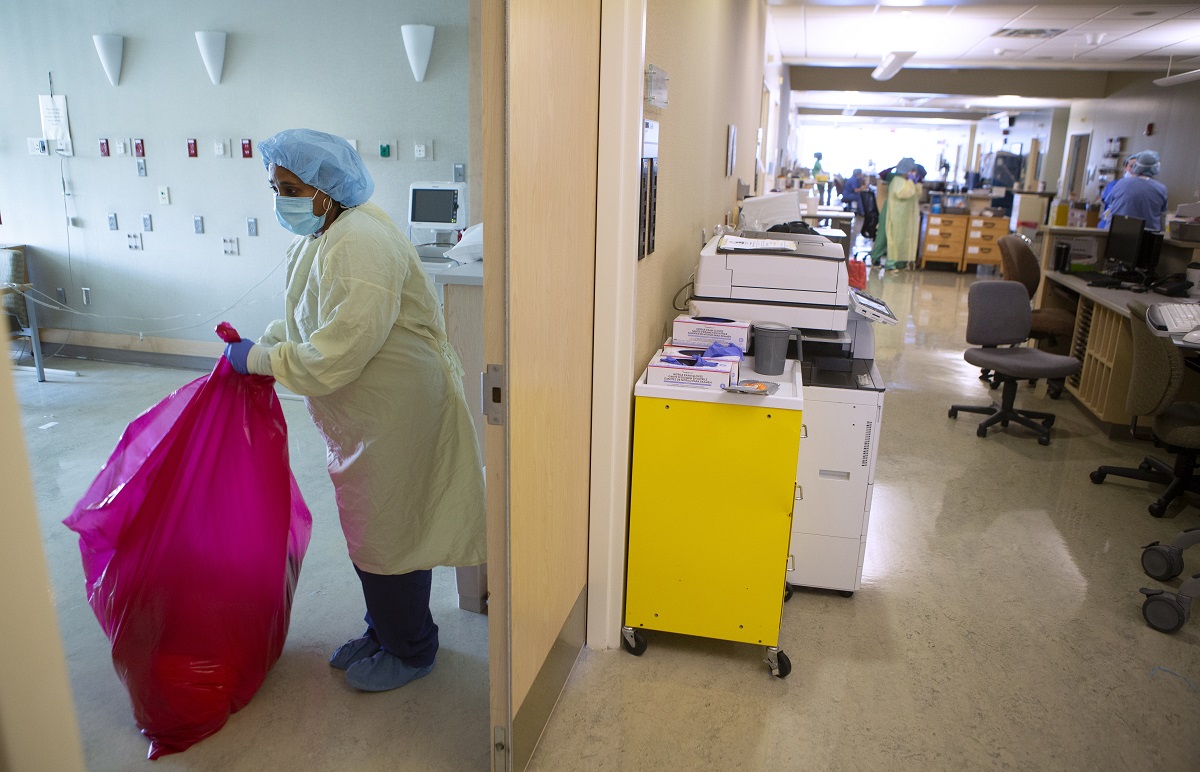Penn State Health employees practice safety first when cleaning patient rooms, operating rooms

When she cleans patient rooms at Penn State Health Milton S. Hershey Medical Center, Marissa Groff-Magyar receives many compliments from patients. “Their kind words make me feel good because it tells me I’m doing something to help make our patients comfortable and safe,” she says.
Groff-Magyar is part of a team of utility workers and associates with Environmental Health Services (EHS) and the Operating Room (OR) departments that works behind the scenes inside Penn State Health facilities. They use personal protective equipment (PPE), standardized processes and a little extra elbow grease, along with care and compassion. Their never-ending goals: to keep patient environments clean and stop the spread of viruses like COVID-19 during the pandemic.
While COVID-19 brought some changes to cleaning procedures at both the Milton S. Hershey Medical Center and Penn State Health St. Joseph Medical Center, many things remained the same. “All the chemicals we use to clean were already rated for COVID-19 before the pandemic, so we’re using those same products now,” says Kristofer Miller, quality coordinator and EHS hiring manager at Hershey Medical Center.
Here’s a detailed look at the cleaning process and the people who make it happen:
Patient Rooms
Workers at both hospitals follow an industry-standard seven-step process when cleaning rooms between patients. Those steps include:
- Removing all waste and linens
- High-dusting surfaces above eye level
- Damp-wiping all high-touch surfaces (light switches, doorknobs, bed rails, bedside tables, phones, call buttons, etc.)
- Cleaning the restroom
- Dry mopping the floor
- Inspecting the room
- Damp mopping the floor
“We wear masks and gowns when cleaning patient rooms,” says Joi Randolph, an EHS associate at St. Joseph Medical Center. EHS employees also clean in a sequential order, working counterclockwise from one end of the room to the other, to make sure they touch every surface.
For rooms once occupied by COVID-19 patients, EHS employees wipe and clean all surfaces twice before mopping. They also wear additional PPE, including gowns, hair covers and shoe covers. And they treat all waste as infectious, double-bagging it and wiping down the outer bag. It takes roughly 45 minutes to clean a non-COVID-19 room and 90 minutes to clean a COVID-19 room.
To ensure rooms meet hospital standards after each cleaning, EHS managers at Hershey Medical Center swab two random high-touch surfaces for adenosine triphosphate (ATP), a molecule present in all organic materials. A machine then measures the swab for an ATP level of 50 or below. Anything above 50 gets recleaned. “In July 2020, our tested surfaces were in the 94th percentile for cleanliness,” Miller says.
At St. Joseph Medical Center, EHS supervisors perform a black-light inspection of high-touch surfaces after cleaning.
Operating Rooms
To clean operating rooms between surgeries, EHS employees follow the same seven-step process as patient room cleaners. They also clean COVID-19 rooms twice. And they take one additional step before entering the room. “We keep the door closed and wait for the room’s ventilation system to run through two air exchanges to ensure there are no pathogens in the air,” says Tealia Hutter, a day-shift aide in the ORs at Hershey Medical Center.
Another difference: while one employee typically cleans a patient room, a team of two employees clean an OR. It takes about 25 minutes to clean a non-COVID-19 OR and 45 minutes to clean a COVID-19 OR.
Once all surgeries are finished for the day, the ORs receive a more thorough scrubbing, called a “terminal clean.”
“We wash the walls, clean all equipment, carts, ceilings and air vents—everything, from top to bottom,” says Lucia Hernandez, a terminal cleaner at St. Joseph Medical Center.
EHS and OR employees remain updated on best practices for infection prevention through ongoing education and frequent updates. “When the pandemic started, we had meetings every day so we were all using the same procedures,” Hernandez says.
“Whenever I had a question, it was addressed immediately, which is how I know cleaning is safe,” Hutter says. “I feel like our work is incredibly important and rewarding because we know we’re keeping our hospital clean and protecting our patients.”
If you're having trouble accessing this content, or would like it in another format, please email Penn State Health Marketing & Communications.
